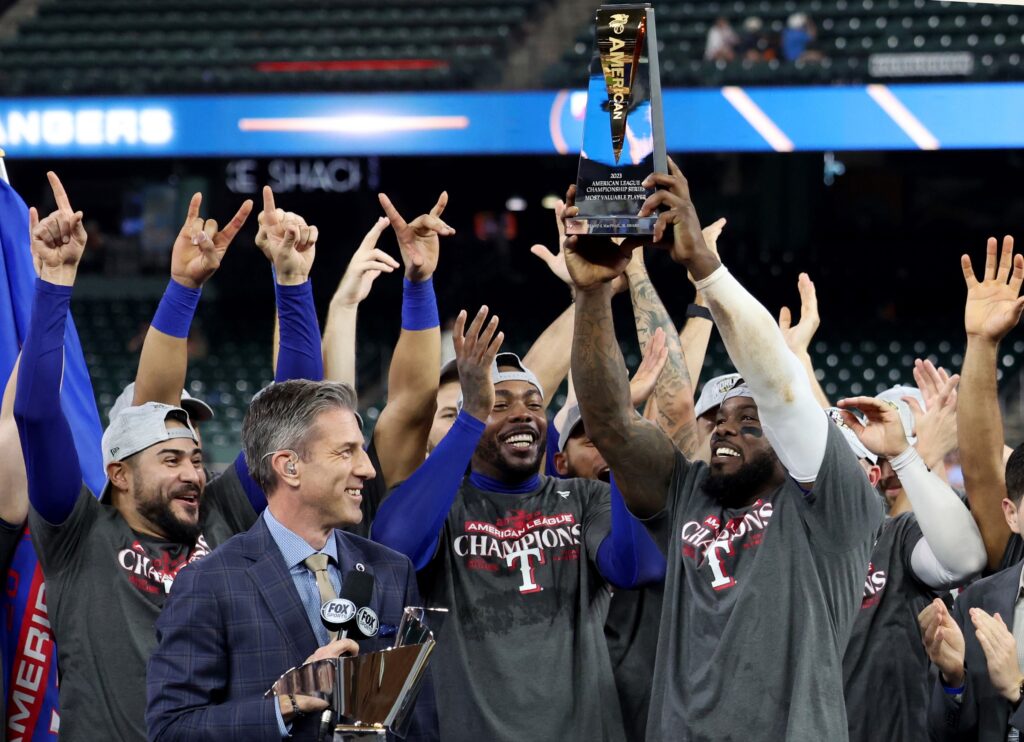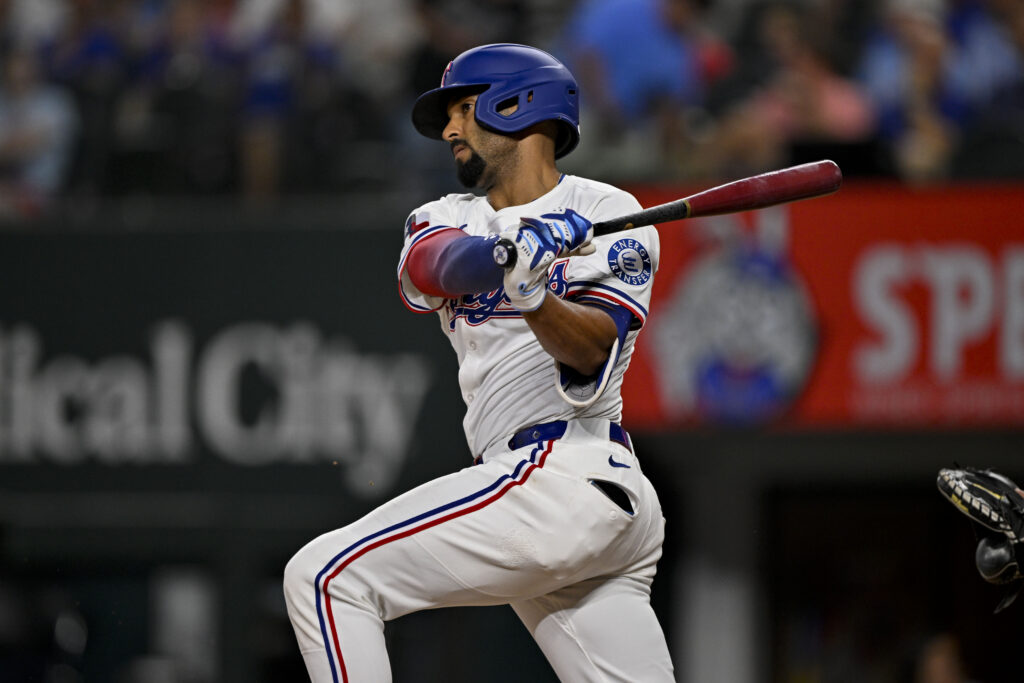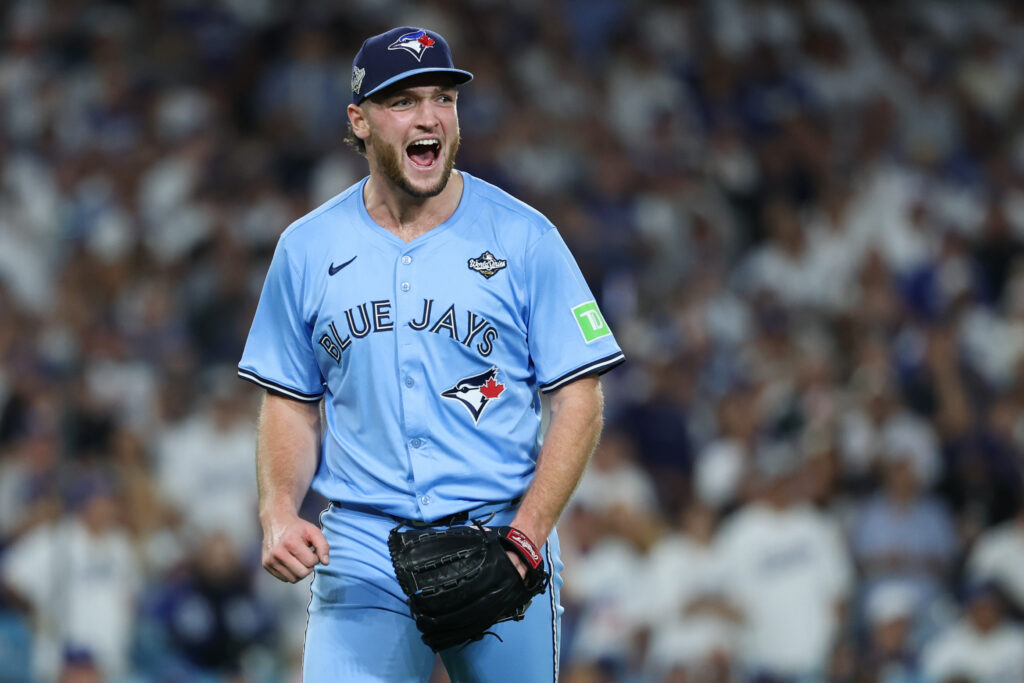In thrilling fashion, the Texas Rangers defeated the Houston Astros in Game 7 to secure their ticket to the World Series. Through parts of this season, the Rangers looked dominant. By the end, they were struggling to put together wins. It did not matter once the playoffs started as they cruised through the first two rounds before a hotly contested series with Houston. Nearly every player on this roster deserves credit, but a few stood out above the rest.
Five Players Who Led the Texas Rangers to the World Series
Adolis García
Where else could we start? It’s not often you see someone mash 15 RBIs in a postseason series. Adolis García was at the center of all the theatrics. After being hit by a pitch to incite a bench-clearing, he responded with a grand slam the following day.
In the series winner, he hit two home runs to secure his nod for series MVP. Those two home runs came on a fastball on the outside edge and a first-pitch curveball hanging over the middle of the plate. His grand slam was another fastball, this time at the top of the zone. In Game 5, it was an inside fastball. Game 4, a changeup.
García was hitting just about everything. The whole idea of facing García in the four-spot in this lineup is pretty much the reason why it’s called cleanup. First, you have to deal with players like Marcus Semien, Corey Seager, and Evan Carter, just to try to get this guy out? That’s a tough ask for any pitcher.
Here’s just a little food for thought on this dynamic. García hasn’t walked once this postseason… If you are the opposing team, you probably don’t have many free bases to give up since the top of the lineup is so good. How carefully can teams pitch around him? Do you just nibble around the zone at the risk of giving up an uncompetitive plate appearance?
We shouldn’t have expected any less from García. In the final month of the season, he had a 147 wRC+, including seven home runs over 74 plate appearances. Even with the rest of the talent on this team, it’s hard to imagine the Rangers clinching the pennant without him. Here’s just a little food for thought before we move on. García hasn’t walked once this season… If your the opposing team, you probably don’t have many free bases
Corey Seager
Corey Seager slowed down in the Championship Series (“slowed down,” meaning an .819 OPS), but was a pivotal part to their dominant run through the Wild Card and Division series. Seager has a .333 average this postseason with three home runs.
So much of his value comes from his plate approach. His aggression is a hallmark symbol of what has made this Rangers team successful. Even though he can push pitchers early in counts, he still posts low strikeout numbers with a bunch of walks just to add to an opponent’s troubles. In the postseason, he is striking out less (seven strikeouts in 58 plate appearances) than he did in the regular season. The prime example of this was his nine-walk series against the Baltimore Orioles in only three games.
Evan Carter
How about this rookie, huh? As the season was winding down, it seemed like a “Gee! Well, that was fun, can’t wait to see him improve in the regular season next year.”
Turns out that might have been a bit cautious. Instead of merely filling in as a role player or helping fit in rest days for other players, Evan Carter has become as crucial to the Rangers’ lineup as anyone. He is slotting in the third spot in the order, just ahead of García as mentioned, to provide a masterful plate approach for someone so inexperienced at the major league level.
Carter is batting .308 this postseason with a .987 OPS. He’s already racked up six doubles this postseason with some gripping defensive highlights to add to his value. How about adding eleven walks and three stolen bases, too? The Rangers might have their hands on a fascinating and entertaining, well-rounded player. Even just watching his demeanor at the plate is an interesting exercise as he now has spent almost 40% of his MLB plate appearances in the postseason.
Nathan Eovaldi
Alright, time for some fun with the pitchers. Any successful team in the postseason is going to have a strong helping of both offense and defense, but the starting pitching for Texas always seemed a bit sketchy. You had Jordan Montgomery set to go, but Nathan Eovaldi struggled with a forearm injury late in the season and Max Scherzer was questionable to even pitch in his first turn against the Astros.
Yet once again, Eovaldi made an unmistakable impact in a playoff run. The Rangers have won all four of his starts this October as he has posted a 2.42 ERA while striking out 28 batters in 26 innings. Interestingly, though, he only managed five whiffs in 88 pitches in his last start against the Astros, yet still struck out four batters.
One of the most encouraging notes for Eovaldi is the return of his fastball velocity. In late September, his velocity dipped with some worrisome results. He was ready to go for October, though, and the Rangers ran with each opportunity.
Jordan Montgomery
What a wild few years for Montgomery. After being traded from the New York Yankees to the St. Louis Cardinals, he found himself on a World Series-bound team in Texas (largely due to his own arm). His fastball-curveball combo has been working wonders with a 2.16 ERA this postseason.
As the competition narrows and the moments get tougher, here is one interesting note. Montgomery has a 1.28 WHIP this postseason. For comparison, Eovaldi has a 0.96 WHIP this season. If Montgomery is going to allow just that slight bit of extra traffic, it will be interesting to see if his World Series opponents can lock in to his pitch mix or if a few lucky balls get through on the hard-contact he allows.
Montgomery has made plenty of memorable moments this postseason already. From his stellar start against the Tampa Bay Rays to kick off the Rangers’ run to a 2 1/3 inning cameo in Game 7 against the Astros, Montgomery has simply been pitching well, with or without overpowering velocity or strikeout numbers. Texas has made it to the World Series with a whole bunch of home runs, but make sure to give the pitchers their due.
Main Image: Thomas Shea-USA TODAY Sports



